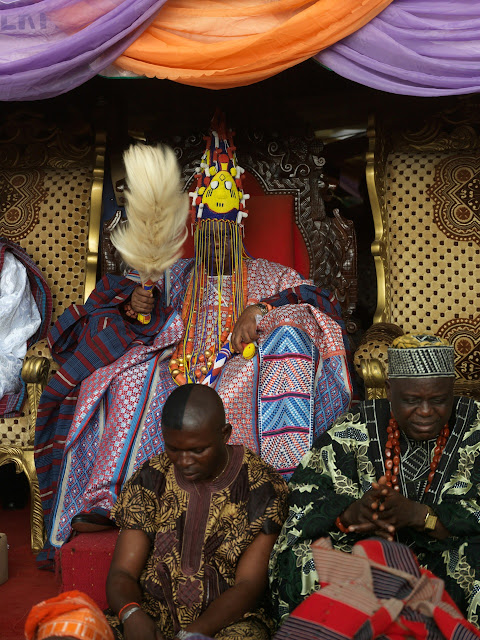 |
| George Osodi. HRM Solomon Akenzua, Oba Erediauwa of Benin Kingdom. (2012) |
In January, 7 images out of the many were featured in Tafeta Gallery in London, in an exhibition entitled Royalty. Upon my first examination of Osodi’s sundry collection of Nigerian royalty from our multitudinous ethnicities is a rich exploration and presentation of Nigerian culture within our traditional forms of governance. But my second look finds something darker. A quite overt flex and showcase of wealth and power. Each image but a few holds in it a buff-chested exhibition of sovereignty, which I don’t believe comes from Osodi’s capturing of them but from the subject themselves, the kings and queens. Osodi’s goal was to document these images for posterity; where in the past there has been a lack of documentation and therefore a loss of identity or a documentation from the colonial perspective which coincided with moments where the traditional leaders were rendered powerless by the colonial masters. But now in a post-colonial, corruption-ridiculed Nigeria where the bourgeoisie has sub-alternated for the colonial masters to be the exploitative governing body these images of these ornamented extravagant leaders is almost like a slap in the face.
The images are dominated by mise-en-scene that supports the narrative of extravagance with wide shots to let the viewer’s eye focus in on key items that properly represent the level of their wealth. For example, the image of The Emir of Kano is a wide shot allowing you to take in the vastness of the setting while still drawing attention to main elements of the image. In the picture, the Emir sits in the backseat of his classic British Rolls Royce, a clear symbol both of wealth and colonial times, both of which he showcases proudly. His face is wrapped in white cloth and a servant stands to the side of him, outside of the car holding a sizeable umbrella over him. There is an excessiveness to the image that makes it achieve what it aims to achieve. Why else would the Emir of Kano choose this moment, while a photographer is present to hop into his green Rolls Royce, surrounded by his servants dressed also in green in the exterior of his palace also containing shades of green? The green is quite fitting as it is a colour often associated with wealth and greed.
 |
|
George Osodi. Emir of Kano’s Rolls Royce (2012). Image via tafeta.com
|
 |
|
Giambattista Tiepolo. The Banquet of Cleopatra (1743-1744).
|
Another theme that is clearly present in this set is the male bravado of the kings. In a very simple way, the set embodies some of Nigeria’s most annoying issues, encouraged patriarchy, male supremacy and the sovereignty of the bourgeoisie. Nigerians are known to tolerate the wealthy and men in general, even at their worst. The images feature the unsmiling faces of the kings, showing off their opulence or any other form of superiority they can grasp. One image especially evokes this. The Ewi of Ado-Ekiti holds his Irukere, lifted up in his hands and captured in motion as if he is blessing us the viewer with the power bestowed upon him. It is ironic in a sense, we can imagine the viewers as common people, whom usually are the ones with the power to instate the rulers into power. Yet here The Ewi is blessing us with the power bestowed upon him by us. An interesting metaphor for the relationship between Nigerians and their government.
 |
|
George Osodi. HRM Alayeluwa Oba Rufus Adeyemo Adejugbe, Aladesanmi III, The Ewi of Ado-Ekiti (2013).
|
 |
|
George Osodi. HRH Queen Haji a Hadizatu Ahmedu, Magajiya of Knubwada (2012). Image via tafeta.com.
|
No comments:
Post a Comment